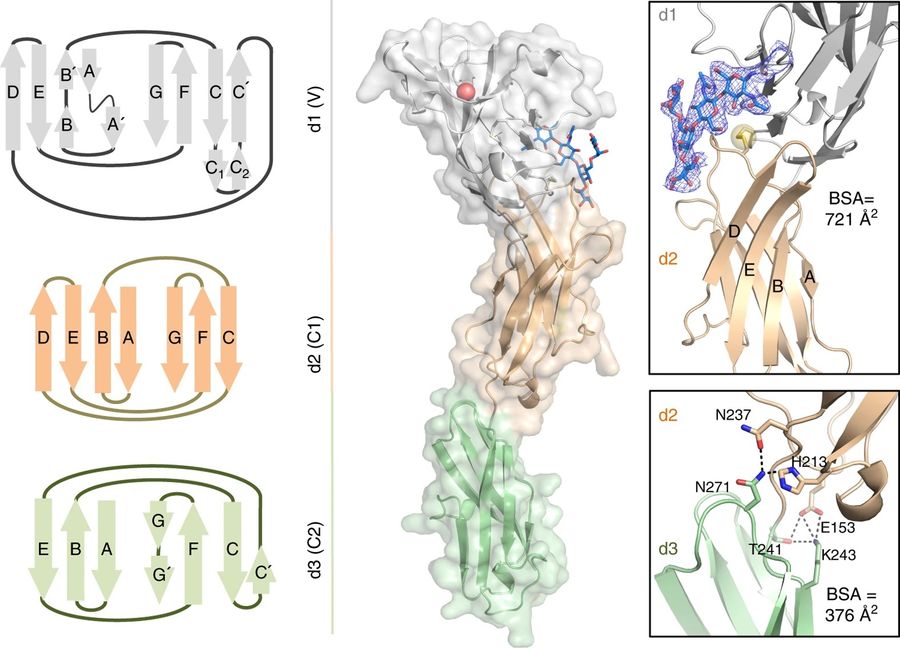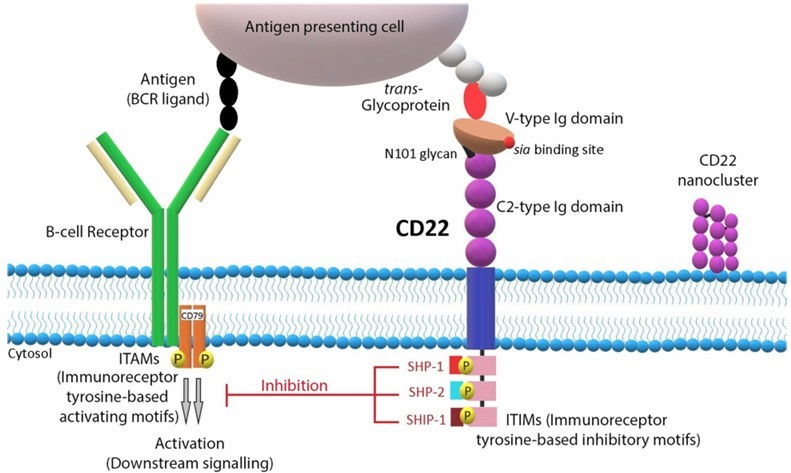| Catalog# | Product Name | Size | Price | Qty | Inquiry |
|---|---|---|---|---|---|
| THP-0208 | Inotuzumab ozogamicin | 1 vial | $3,998.00 |
|
Add to Cart Order |
CD22 is a transmembrane glycoprotein primarily expressed on B cells, where it regulates immune responses by modulating B cell receptor (BCR) signaling. As a key inhibitory co-receptor, CD22 plays a critical role in maintaining immune homeostasis and preventing excessive immune activation. Given its involvement in B cell malignancies and autoimmune diseases, CD22 has been extensively studied as a therapeutic target.
NCBI Gene ID: 933
UniProtKB ID: P20273
CD22 is a type I transmembrane protein composed of seven extracellular immunoglobulin-like domains, a transmembrane region, and a cytoplasmic tail containing multiple immunoreceptor tyrosine-based inhibitory motifs (ITIMs).
 Figure 1. Three-dimensional structure of human
CD22. Crystal structure of the three N-terminal Ig domains of human CD22 (d1–d3) represented as a schematic diagram, secondary structure cartoon, and
transparent surface. (Ereño-Orbea, et al., 2017)
Figure 1. Three-dimensional structure of human
CD22. Crystal structure of the three N-terminal Ig domains of human CD22 (d1–d3) represented as a schematic diagram, secondary structure cartoon, and
transparent surface. (Ereño-Orbea, et al., 2017)
Upon binding to the B cell receptor (BCR), CD22 acts as a key negative regulator by recruiting the Src homology 2 domain-containing protein tyrosine phosphatase (SHP-1). This phosphatase dephosphorylates key signaling molecules, resulting in the downregulation of BCR-mediated signaling cascades and a reduction in B cell activation. By dampening excessive immune responses, CD22 plays a critical role in maintaining immune tolerance and preventing autoimmune diseases such as systemic lupus erythematosus (SLE) and rheumatoid arthritis (RA), in which overactive B cells contribute to disease pathology.
In addition to its role in BCR signaling, CD22 also functions as an adhesion molecule, interacting with sialylated ligands on neighboring cells. These interactions are essential for B cell migration, homing, and retention in specific tissues, allowing for proper immune surveillance and response modulation. By regulating the localization of B cells in lymphoid organs and inflamed tissues, CD22 further influences immune function and disease progression.
 Figure 2. CD22 structure and signaling pathway.
CD22 molecule is a transmembrane protein from SIGLEC (Sialic acid-binding immunoglobulin-type lectins) family. It has three parts: (i) V-type Ig domain with
sia-binding site, (ii) C1-type Ig domain, (iii) C2-type Ig domain. The CD22 intracellular region contains ITIMs (Immunoreceptor tyrosine-based inhibitory
motifs). The tyrosine residues of the ITIMs become phosphorylated with the ligand binding, which leads to activation of SHP-1 (Src homology region 2
domain-containing phosphatase-1), SHP-2 (Src homology region 2 domain-containing phosphatase-2), SHIP-1 ((Src homology region 2 domain-containing inositol
5′ polyphosphatase-1). These phosphatases act as negative regulators for down-streaming signaling from B-cell receptors. (Aujla et al., 2019)
Figure 2. CD22 structure and signaling pathway.
CD22 molecule is a transmembrane protein from SIGLEC (Sialic acid-binding immunoglobulin-type lectins) family. It has three parts: (i) V-type Ig domain with
sia-binding site, (ii) C1-type Ig domain, (iii) C2-type Ig domain. The CD22 intracellular region contains ITIMs (Immunoreceptor tyrosine-based inhibitory
motifs). The tyrosine residues of the ITIMs become phosphorylated with the ligand binding, which leads to activation of SHP-1 (Src homology region 2
domain-containing phosphatase-1), SHP-2 (Src homology region 2 domain-containing phosphatase-2), SHIP-1 ((Src homology region 2 domain-containing inositol
5′ polyphosphatase-1). These phosphatases act as negative regulators for down-streaming signaling from B-cell receptors. (Aujla et al., 2019)
CD22 is highly expressed on mature and precursor B cells, making it a valuable biomarker and therapeutic target for B cell malignancies. In conditions such as B cell acute lymphoblastic leukemia (B-ALL) and non-Hodgkin's lymphoma (NHL), CD22 expression remains intact, providing an avenue for targeted therapies.
CD22 dysfunction has been implicated in autoimmune disorders such as systemic lupus erythematosus (SLE) and rheumatoid arthritis (RA). Reduced CD22 expression or function leads to hyperactive B cells and autoantibody production, exacerbating disease pathology. Strategies to enhance CD22 signaling or restore its inhibitory effects are being explored as potential therapeutic approaches.
While CD22 plays a role in the regulation of several B cell functions, its involvement in protection against viral infections remains uncertain. Studies have shown that CD22-/- mice infected with lymphocytic choriomeningitis virus, vesicular stomatitis virus, or Staphylococcus aureus show no difference in survival compared to wild-type (WT) mice. However, CD22 deficiency has been associated with increased susceptibility to West Nile virus (WNV) and accelerated progression of murine AIDS (MAIDS) caused by murine leukemia virus. In CD22-/- mice, the onset of splenomegaly and lymphadenopathy is more rapid, occurring within four weeks of infection.
CD22-directed chimeric antigen receptor (CAR) T-cell therapy has shown promise, particularly in CD19-negative relapsed B-cell malignancies, expanding treatment options for B-cell leukemia and lymphoma.
In summary, by exploiting CD22's ability to regulate BCR signaling and its selective expression on B cells, CD22-targeting drugs offer precision therapy for B-cell cancers and autoimmune diseases, minimizing off-target effects and improving therapeutic efficacy.
Creative BioMart specializes in providing high-quality therapeutic proteins. Explore our products directly or contact us for any questions or inquiries!
References
For more information on how our products could help advance your project, please contact us.
ENTER YOUR EMAIL HERE TO SUBSCRIBE.
Copyright © 2025 Creative BioMart. All Rights Reserved.